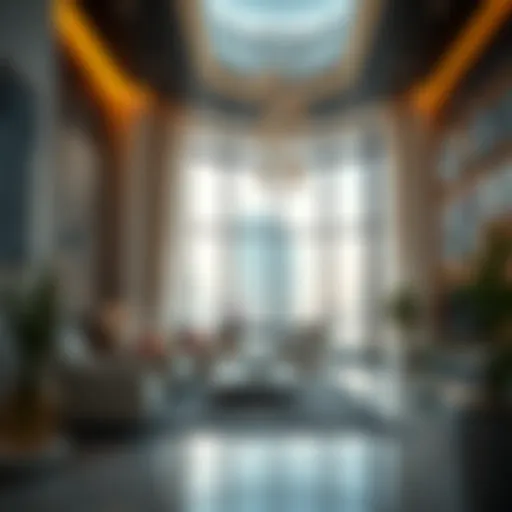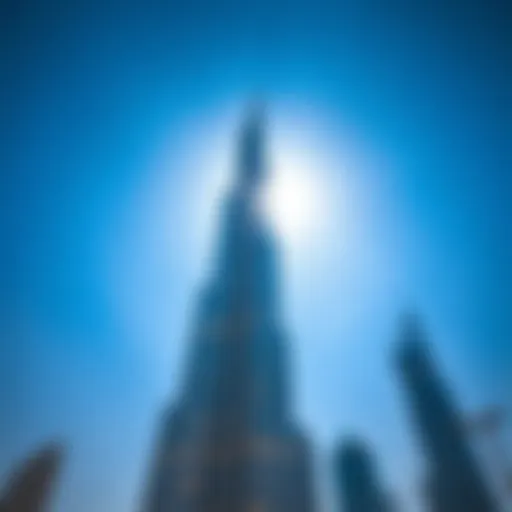Diverse Housing Designs in the UAE: A Comprehensive Study
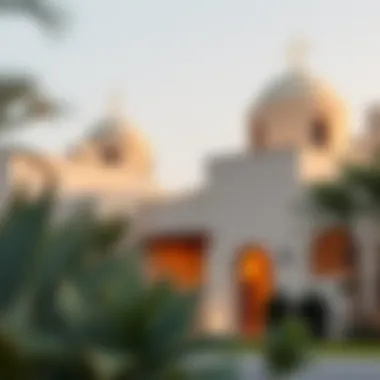
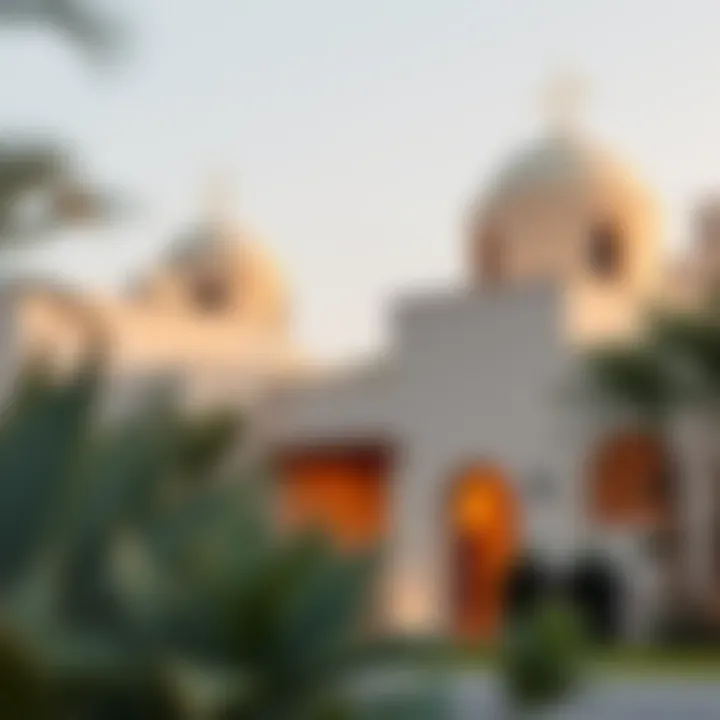
Intro
Understanding the diverse landscape of housing in the United Arab Emirates is crucial for anyone looking to buy, invest, or manage property in this dynamic region. The UAE's real estate market is steeped in cultural heritage while simultaneously racing towards modernity, creating a unique blend of architectural styles that reflect the aspirations and lifestyles of its inhabitants. From the traditional barasti homes made of palm fronds to opulent beachfront villas that stretch along the coast, each housing type tells a story that connects its past to present.
As we venture deeper into this discussion, we will peel back the layers of the housing market, highlighting current trends and future predictions that shape the real estate landscape. A thorough understanding of what influences housing design—including sustainability and globalization—will also be essential. This exploration is particularly relevant as it offers both homebuyers and investors valuable insights into making informed decisions.
The architecture in the UAE does not merely house families; it reflects social structures, cultural values, and economic contexts. This makes it imperative to recognize how different types of residences symbolize the rich tapestry of life in the Emirates.
Market Insights
Current Trends in Dubai Real Estate
The real estate market in Dubai has experienced significant fluctuations over the years, yet, currently, it’s emblematic of a robust recovery. Recent reports indicate a notable uptick in demand for both luxury apartments and villas as expatriates return and new residents flock to the city.
Several trends are shaping the market:
- Sustainability: Eco-friendly developments are on the rise, with buildings incorporating energy-efficient systems and sustainable materials.
- Wellness-focused spaces: Properties with amenities aimed at promoting wellness, such as fitness centers and greenery, are increasingly desirable.
- Smart technology integration: Homes equipped with smart tech are gaining traction, appealing to tech-savvy buyers who prioritize convenience and efficiency.
For investors, recognizing these trends can spell the difference between a fruitful investment and one that flounders. Investors are advised to delve into neighborhoods like Dubai Marina and Jumeirah Beach Residence, known for their high rental yields and popularity.
Analysis of Future Predictions
Looking ahead, the Dubai real estate market shows substantial promise. Experts predict steady growth fueled by several factors:
- Expo 2020's long-term influence: The aftermath of the Expo is expected to bolster tourism and expatriate influx, leading to sustained property demand.
- Regulatory improvements: Ongoing legal reforms in property ownership aim to foster transparency, making Dubai more attractive to global investors.
In a nutshell, as factors like sustainability and technology continue to intersect with housing design, the future of residential properties in the UAE promises to be both innovative and culturally resonant.
"Investing in real estate in the UAE is not just about property; it’s about embracing a lifestyle that intertwines tradition with cutting-edge design."
By understanding these market insights, potential buyers and investors can better navigate the complexities of the housing sector while seamlessly connecting with the cultural narrative woven into the very fabric of UAE life.
Traditional Emirati Homes
Traditional Emirati homes hold a prominent place in the architecture and social structure of the UAE. These structures are not merely dwellings; they are a reflection of the cultural heritage and historical evolution of the region. Understanding these homes is vital as they reveal how the climate, lifestyle, and social interactions have influenced housing designs across the UAE.
Architecture and Design
Materials Used
The materials used in traditional Emirati homes mainly include mud bricks, palm fronds, and stone, focusing on sustainability and availability. These materials are enduring choices for various reasons: they are often sourced locally, which reduces transportation costs and supports the local economy. Mud bricks, for example, have excellent thermal properties that help keep homes cool during the scorching heat of summer.
One unique advantage of using mud is its natural insulative qualities, making it an excellent option for hot climates. However, these materials can also absorb moisture, which could lead to structural issues over time. While they afford a rustic charm, the maintenance required poses a challenge for modern homeowners.
Cooling Techniques
Cooling techniques in traditional homes reflect the genius of ancient architecture in a harsh climate. Common practices involved thick walls, high ceilings, and strategically placed wind towers (or Barjeel) designed to capture even the slightest breeze. Such features allow for natural ventilation, significantly reducing indoor temperatures.
The clever use of these techniques not only enhances comfort but also minimizes reliance on artificial cooling systems, which can be costly and energy-intensive. However, it's important to mention that these techniques might not be as effective in today's rapidly urbanizing environment where buildings are densely packed, reducing airflow.
Social Spaces
Social spaces in Emirati homes reveal the communal spirit embedded in the culture. Traditionally, homes featured large courtyards that served as gathering spots for family and guests. This design element fosters interaction, emphasizing sociability and hospitality.
The inclusion of these spaces encourages family bonding and communal activities, making them a popular choice in residential design. However, the challenge lies in balancing openness with privacy, as larger social spaces can make it difficult to maintain personal boundaries within the family structure.
Cultural Significance
Role in Community
The role of traditional homes in the community extends beyond shelter. They are the heart of social interaction and cultural exchange. The layout of these homes was generally designed to include spaces for gathering, which speaks to the importance of community ties in Emirati culture.
Additionally, homes often served as venues for cultural events, celebrations, and gatherings. This characteristic fosters a strong sense of identity among residents, making traditional homes a vital part of community life. The commitment to maintaining these homes underscores the value placed on heritage. However, changing lifestyles may challenge the continued use of such spaces in contemporary society.
Family Structure Reflection
Traditional Emirati homes mirror the family structure prevalent in Emirati society. The arrangements often reflect extended family living together, highlighting intergenerational bonds. Separate quarters for different family units promote both privacy and communal living, making them a fitting representation of familial relationships.
This reflection fosters respect for elders and strengthens familial support systems. In contrast, the modern shift towards nuclear families may render these substantial designs less relevant, influencing trends in new developments.
Historical Context
Examining the historical context of these homes shows how architecture is shaped by social and environmental factors. Historically, the simple yet functional designs emerged from the necessity of withstanding the harsh desert climate. Traditional homes were often built around a central courtyard, serving practical purposes while demonstrating architectural ingenuity.
Moreover, these homes are evolving. Over the years, modernization has gradually incorporated traditional design elements into contemporary architecture, bridging the past with the present. This blend maintains cultural relevance, as many families seek to honor their heritage while adapting to modern conveniences. However, the risk exists that as modernization prevails, the fundamental aspects of these homes could be lost.
A well-preserved traditional home not only offers a glimpse into history but also serves as a reminder of communal values that defined a society.
In summary, traditional Emirati homes are far more than physical structures; they are expressions of cultural identity, social relationships, and historical context. They embody how architecture responds to environment and societal needs while reflecting on the intricate ties that bind communities.
Contemporary Villas
Contemporary villas represent a fascinating chapter in the narrative of housing types in the UAE. They epitomize modern aesthetics while offering practical advantages that resonate with today's lifestyle choices. The importance of exploring this category lies in the blend of luxury and functionality, appealing to a broad spectrum of residents and investors. As urban areas continue to expand, the demand for these villas has surged, making them a critical focus in the current real estate landscape.
Design Trends
Open Spaces
Open spaces in contemporary villas are more than just a design trend; they encapsulate a cultural shift towards communal living and connectivity. This architectural style facilitates the flow of natural light and enhances the feeling of spaciousness, which is particularly valued in a region where indoor living is prevalent. Large, airy living areas often blur the lines between indoor and outdoor environments, integrating gardens or patios that serve as an extension of the home.
The key characteristic of open space is its emphasis on flexibility. Homeowners can adapt the layout based on their needs, whether it's family gatherings or intimate dinners. This versatility makes open spaces a popular choice in the UAE, where cultural practices often revolve around hospitality.
However, while open spaces provide a variety of advantages, like promoting social interactions, there can be challenges too. The upkeep of larger areas could be time-consuming and, depending on design, privacy may be compromised.
Smart Home Technologies
The incorporation of smart home technologies into contemporary villas marks a significant advancement in how residents interact with their living spaces. Features such as automated lighting, security systems, and climate control provide convenience and efficiency that many homebuyers find appealing in today’s fast-paced world. These technologies not only enhance the quality of life but also contribute to energy savings, which is crucial in desert climates.
One of the standout features is the capability for remote control; homeowners can manage their devices from anywhere, ensuring peace of mind and comfort. The adaptability of smart technologies to personal preferences is another reason behind its growing popularity.
On the flip side, reliance on technology does introduce potential vulnerabilities. Privacy concerns surrounding data security are something prospective buyers might ponder, and the initial setup can be costly. Nevertheless, for many, the benefits outweigh these downsides.
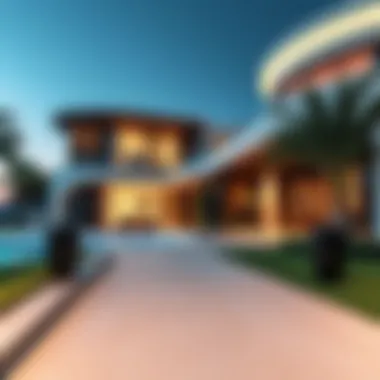
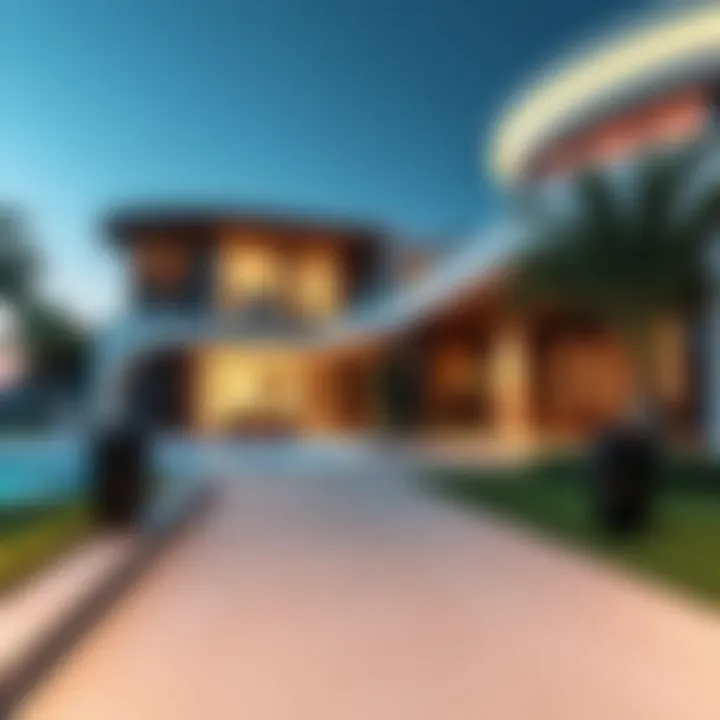
Luxury Features
In the realm of contemporary villas, luxury features often set one property apart from another. From expansive swimming pools to elaborate outdoor entertaining areas, these features not only enhance the overall living experience but also boost the property’s market value. A striking kitchen with high-end appliances or an opulent master suite can become focal points that attract discerning buyers.
Luxury in contemporary villas also encompasses eco-friendly options, such as energy-efficient appliances and sustainable materials. This focus on sustainability aligns well with the growing trend towards green living, making these properties not just a status symbol, but a responsible choice too.
However, while appealing, luxury features often come with increased costs, both in terms of initial investment and ongoing maintenance. Potential buyers must weigh these aspects carefully against their budget and lifestyle needs.
Market Dynamics
Demand and Supply
The demand for contemporary villas has exploded in recent years, driven largely by aspirations for an upscale lifestyle among UAE residents and investors. New developments often cater to this growing market, with luxurious amenities and prime locations. The availability of land and the speed of construction influence the supply side; thus, understanding this dynamic is vital for potential buyers and those in real estate.
The key characteristic defining the demand is its responsiveness to global trends, with residents yearning for homes that offer not just comfort, but also prestige. This makes the category appealing for investors seeking high returns.
However, fluctuations in demand can lead to challenges when it comes to pricing, making it necessary for buyers to stay informed about market conditions.
Investment Potential
In terms of investment potential, contemporary villas often deliver high returns due to their desirability among both local and expatriate communities. Given the growth trajectory of the region, these properties can serve as robust assets in a diversified portfolio.
What sets these villas apart as worthwhile investments is their capacity to attract buyers looking for long-term ownership or rental incomes. Yet, market fluctuations due to economic changes or regulatory shifts can create risks that savvy investors need to navigate carefully.
Target Demographics
Understanding target demographics is crucial for those interested in contemporary villas. Typically, these properties attract a mix of affluent Emirati families, expatriates, and international investors. Their preferences lean towards spacious living quarters, connectivity to urban hubs, and proximity to amenities.
The unique aspect of targeting these demographics is the diversity it encompasses. Customized marketing strategies can address various needs from luxury seekers to eco-conscious home hunters. On the downside, this varied audience requires deeper market research, which can be resource-intensive but ultimately rewarding when executed wisely.
Apartments and Condominiums
Apartments and condominiums play a pivotal role in the housing landscape of the United Arab Emirates. With rapid urbanization and ever-growing population influx, these types of dwellings offer a practical and flexible solution for many residents. Whether you're a single professional, a young couple, or a growing family, the appeal of apartments and condominiums often lies in accessibility, community resources, and modern living options that cater to a diverse population. Understanding these aspects is essential to grasp the full spectrum of housing in this dynamic region.
Urban Living
Accessibility to Amenities
The accessibility of amenities in apartments and condos is one of their most attractive features. Living in close proximity to shops, schools, and health facilities drastically reduces daily commute times and enhances the quality of life. In cities like Dubai and Abu Dhabi, many residential buildings are strategically placed near major malls, educational institutions, and parks, making them a popular choice for families and individuals alike.
Furthermore, these locations often enhance convenience; residents might enjoy services like grocery stores, cafes, and fitness centers right within their buildings or just a stone's throw away. This ease of access significantly influences lifestyle choices, favoring a move towards densely populated urban environments where everything one needs is within arm's reach. However, crowdedness can also pose disadvantages, particularly in rush hours when public transport or roads become congested.
Community Facilities
The apartment living experience is often enriched by community facilities available within or near condominiums. These may include swimming pools, gyms, gardens, and children's play areas. Such amenities foster social interactions among residents, creating a sense of community that many people find appealing. Having spaces for recreational activities or gatherings encourages neighborly connections, making life a bit more enjoyable.
A unique feature of community facilities is that they often cater to a wider range of interests. For instance, some apartment complexes might even include study lounges or co-working spaces for the remote workforce, providing an environment conducive to productivity. On the flip side, these facilities can sometimes lead to disputes over usage or maintenance responsibilities, which can sour the community spirit if not properly managed.
Modern Designs
Modern designs in apartments and condominiums incorporate innovative architectural practices, fused with an aesthetic appeal that reduces the divide between functionality and style. Features such as open floor plans and large windows for natural lighting have become the norm. Many buildings embrace eco-friendly designs by implementing sustainable materials and energy-efficient systems.
These contemporary design choices facilitate an efficient use of space and enhance the overall living experience. Moreover, they often include smart technologies, allowing residents to control lighting, heating, and even security from their smartphones. While these advancements add to the allure of modern designs, they also come with a price tag, occasionally making them less affordable for average buyers.
Renting vs Buying
Following the discussion on urban living, the considerations of renting vs buying present an essential aspect within the apartment and condominium market in the UAE.
Market Trends
Understanding current market trends can provide vital insights for potential investors and homebuyers. The residential market in the UAE has shown fluctuations in demand and pricing, often influenced by overall economic conditions and expatriate population shifts.
Target demographics—such as young professionals or families looking for larger spaces—are also crucial in understanding these trends. For instance, demand for two- to three-bedroom apartments has been on the rise due to changing family dynamics. Buyers may find themselves in a favorable position if they enter the market during a slowdown when prices dip.
Nevertheless, the housing market can be unpredictable. Investors must stay informed about changes to avoid pitfalls amidst external economic challenges.
Financial Considerations
Financial considerations are another critical aspect of the renting versus buying debate. For many people, purchasing an apartment might seem daunting due to down payment requirements and eligibility for mortgages. Even so, the benefits of owning property often outweigh the challenges if you're planning on a long-term stay in the UAE.
Homeownership typically secures an asset that appreciates over time, providing a financial safety net. Yet, renting still holds its merits, especially for newcomers or those anticipating a transient lifestyle. With the flexibility renting offers, it allows individuals to adapt to their living situation without being tied down by the responsibilities that come with ownership, like maintenance and repair costs.
Lease Agreements
Finally, lease agreements are a practical consideration worth examining in the context of apartments and condominiums. A lease outlines the rights and responsibilities of both landlords and tenants, which can greatly impact the renting experience.
Most commonly, leasing terms in the UAE typically span from one to three years, offering stability for tenants. However, some may find themselves facing challenges if terms aren't fully understood or if unforeseen circumstances necessitate early termination. Moreover, different landlords might have distinct rules regarding subletting, which could limit tenants’ flexibility.
In summary, apartments and condominiums encapsulate a multifaceted approach to urban dwelling, with features that cater to various lifestyles and preferences. As the UAE continues to evolve, so will the importance and characteristics of these housing options, making them a topic worth exploring for anyone interested in investing or residing in this dynamic market.
Townhouses
Townhouses hold a prominent place in the diversifying landscape of housing in the UAE. Their design caters well to the needs of modern families while offering a unique blend of privacy and community that appeals to various demographics. As urban centers expand, these homes demonstrate how cities can adapt to growing population demands without sacrificing the quality of life.
Family-Oriented Living
Space Utilization
Space utilization stands out as a critical aspect of townhouses. Unlike standalone villas, townhouses efficiently use vertical and horizontal space, which makes them ideal for families living in urban environments. Many layouts feature open-plan living areas, allowing natural light to flood in.
The key characteristic here is the strategic design that promotes a sense of spaciousness even in smaller square footage. For instance, multi-level layouts often combine living and dining spaces on the ground floor, while bedrooms are tucked away on upper levels, providing both social interaction areas and private retreats.
On the downside, while space might be optimized, some might feel restricted by the close proximity of neighbors. However, the clever layout often compensates for this, fostering a comfortable and practical living space.
Neighborly Interaction
Neighborly interaction is another defining aspect in townhouse communities. These homes often encourage a spirit of togetherness, where families can easily engage with each other, share resources, or simply enjoy communal spaces like gardens or parks. Living in close quarters often fosters social connections, enhancing the community feel.
What sets this apart is the natural tendency for residents to bond over shared experiences, like watching children play or collaborating on community improvements. However, privacy can be a concern for some who prefer quiet environments. Still, the lively atmosphere is a significant draw for families seeking companionship and support.
Pet-Friendly Options
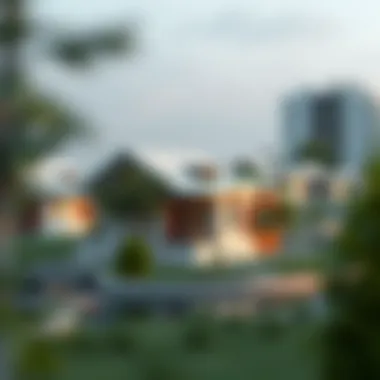
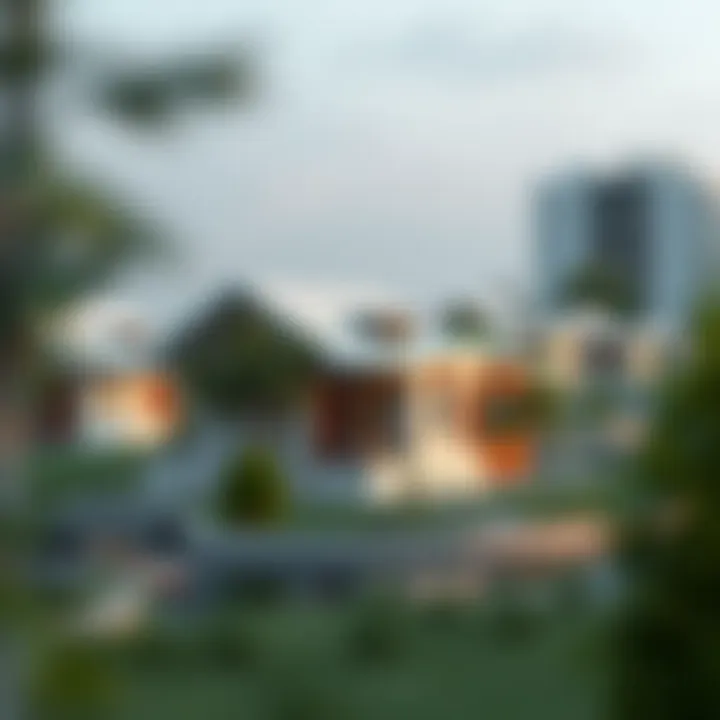
The inclusion of pet-friendly options in townhouse designs has grown in popularity. Many communities now cater to pet owners with designated outdoor areas, making it easier for families with furry friends. These features contribute significantly to the overall attractiveness of townhouses, especially for young families looking for long-term homes.
The primary characteristic that makes this appealing is the balance it strikes between comfortable living for pets and the design aspects of shared spaces. Some townhouses come with fenced yards, while others are nestled in pet-friendly neighborhoods with nearby parks.
However, while these options increase the appeal for pet owners, there can be restrictions that limit certain breeds or sizes. Still, most find the benefits outweigh these minor setbacks.
Architectural Styles
Landscape Design
Landscape design in townhouse developments plays a crucial role in enhancing the aesthetic appeal and ecological footprint of the properties. Lush green areas, gardens, and thoughtful layouts that integrate nature not only beautify the surroundings but also promote sustainability.
The key characteristic is the incorporation of native plants and sustainable landscaping practices that provide minimal environmental impact while maximizing visual interest. Many modern communities focus on creating communal green spaces that not only elevate property values but also foster a connection between residents and nature.
However, maintaining these landscapes requires ongoing effort and resources, which can be a double-edged sword for some developers.
Facade Variations
Facade variations are what make townhouses visually distinct within a neighborhood. Different design elements, such as colors, materials, and architectural styles, contribute to the unique character of each unit.
This variety allows for a rich tapestry of aesthetics that appeals to potential buyers, as they seek homes that reflect their personal style. The benefit here is a sense of individuality within a community, where each household can express itself through its exterior design.
Yet, the challenge lies in balancing this variety with the overall cohesiveness of a development. If not managed well, it can create a disjointed visual experience that detracts from the neighborhood's appeal.
Interior Design Trends
Interior design trends in townhouses reflect a mix of functionality and style, aiming to create comfortable living environments. Open concept layouts, multifunctional spaces, and contemporary finishes are becoming the norm.
The defining characteristic is the focus on practicality without compromising on style. Features like modular furniture, smart technology integration, and energy-efficient appliances resonate well with modern families who are conscious about their spaces.
While these trends are beneficial, they demand a certain level of investment from homeowners, which might not suit every budget. However, their appeal to buyers makes them popular in the market, paving the way for a thriving sector of townhouse living.
Luxury Mansions
Luxury mansions represent the pinnacle of opulent living in the UAE, underscoring not just wealth but also lifestyle aspirations. These grand estates offer more than just space — they embody the intersection of architectural innovation and personal expression, appealing to individuals who desire exclusivity and sophistication. Embracing luxury organizations like high-end malls, world-class restaurants, and cultural landmarks, these homes are often positioned in high-demand areas, making them a significant investment opportunity.
From serene waterfronts in Dubai to the vibrant neighborhoods of Abu Dhabi, the allure of luxury mansions is evident in their unique designs and expansive amenities. Thus, exploring this topic provides valuable insight into how these luxurious homes align with the trends and expectations of UAE residents.
Features and Amenities
Private Pools
Private pools are a hallmark of luxury mansions, serving as both a recreational retreat and a visual centerpiece. These pools not only provide a space for relaxation but also elevate the overall aesthetic of the property. A key characteristic of these pools is their design versatility; from infinity pools that blend seamlessly with the horizon to elaborate water features that transform the backyard into an oasis. The inclusion of such pools adds immense appeal, making them sought after for personal use and entertainment.
However, one must consider the maintenance side of things. Keeping a private pool pristine can be painstaking and costly, particularly in desert climates where temperature fluctuations demand constant care. Still, their attractiveness and potential for hosting vibrant gatherings make private pools a worthwhile investment in the realm of luxury housing.
Home Theaters
The incorporation of home theaters in luxury mansions reflects a growing trend toward creating entertainment-focused living spaces. These dedicated areas, complete with state-of-the-art sound systems and plush seating, cater to those who seek movie-watching experiences akin to that of a commercial cinema. A notable aspect of home theaters is their ability to offer a personalized atmosphere, allowing families to gather while enjoying their favorite films in comfort, free from commercial interruptions.
Yet, while the allure of a home theater is undeniable, it requires an initial investment in technology and space planning. Once these hurdles are addressed, the unique feature of hosting private screenings and movie nights becomes an enduring advantage. The social experience found in home theaters fosters deeper connections among family and friends, enriching the luxury living culture.
Gourmet Kitchens
A gourmet kitchen is another essential feature of luxury mansions, representing the heart of the home where culinary art can flourish. These kitchens are meticulously designed with top-of-the-line appliances, expansive countertops, and innovative layouts, encouraging both cooking and social interactions. The emphasis on gourmet kitchens indicates a lifestyle that embraces culinary creativity, appealing to aspiring chefs and home-cooks alike.
The unique aspect of these kitchens often lies in their integration of technology; smart appliances can streamline cooking processes while enhancing energy efficiency. However, the initial cost of outfitting a kitchen with high-end materials and appliances can be daunting, potentially outweighing some owners' desires for functional extravagance. Still, the convenience and delightful potential they offer validate their place in luxury interiors.
Investment Viability
Understanding the investment landscape related to luxury mansions is crucial for potential buyers. These properties can be both a home and an asset, with opportunities for high returns making them an attractive option in the competitive UAE real estate market.
High-Return Areas
High-return areas are where the property market experiences robust ROI due to demand and developments. Neighborhoods like Palm Jumeirah in Dubai and Al Raha Beach in Abu Dhabi are prime examples where luxury mansions can yield significant rental and resale value. Key characteristics include proximity to commercial centers and top-tier schools, enhancing their appeal to affluent buyers.
Investing in these locations often means a higher price tag, but the long-term benefits can offset those costs, making it an intelligent choice for those looking for financial security.
Market Fluctuations
Market fluctuations can stir excitement and apprehension in equal measure. They highlight the variability in property values, influenced by various economic factors. Regular monitoring of these trends is necessary for prospective buyers and investors, as timing can impact purchasing decisions significantly. A notable aspect to consider is that during economic peaks, luxury mansion prices can skyrocket but may drop during downturns, necessitating a careful approach to investment.
Awareness and research are key advantages to navigating these fluctuations effectively, allowing investors to capitalize on opportunities while minimizing risks.
Buyer Profiles
Understanding buyer profiles is essential in the luxury mansion market. The demographics range broadly from international investors to local affluent families, each with distinct motivations and preferences. High-net-worth individuals often seek luxury for lifestyle benefits, while others view these properties as investment vehicles.
A comprehensive insight into buyer profiles helps sellers and real estate professionals anticipate market demands and align property features with potential buyer interests. This insight translates into strategic marketing and can ultimately lead to quicker sales and higher prices.
Sustainable Housing
Sustainable housing has become a cornerstone of modern architectural practices, especially in a rapidly developing region like the UAE. The increasing awareness of environmental issues, alongside the need for efficient use of resources, drives the relevance of this topic. Sustainable housing not only offers ecological benefits but also enhances the quality of life for residents. Emphasizing energy efficiency, water conservation, and the use of sustainable materials allows homeowners and developers to address pressing environmental concerns while ensuring long-term economic viability.
Green Building Practices
Energy Efficiency
Energy efficiency is a key element of sustainable housing, playing a significant role in reducing energy consumption and minimizing the environmental footprint. Building homes that utilize advanced insulation techniques and energy-efficient appliances can lead to significant savings on utility bills for homeowners. For example, UAE homes are increasingly incorporating technologies such as double-glazed windows and energy-efficient HVAC systems. Such features not only contribute to a lower cost of ownership but also support the UAE's commitment to reducing carbon emissions. The unique characteristic of energy efficiency lies in its dual benefit: achieving savings while promoting environmental responsibility. However, potential drawbacks include the higher upfront costs associated with such technologies which might deter some budget-conscious buyers.
Water Conservation
Water conservation has taken center stage, particularly in arid regions like the UAE where water scarcity poses significant challenges. Implementing systems for rainwater harvesting and drip irrigation can drastically reduce water usage in residential settings. A notable aspect of water conservation in sustainable housing is the popularity of low-flow fixtures and drought-resistant landscaping, which maintain aesthetics without overconsuming this precious resource. Such practices align perfectly with the UAE's vision for a sustainable future. Still, the adoption of these practices can be hindered by initial installation costs and the need for ongoing maintenance awareness among homeowners.
Materials Sustainability
Materials sustainability refers to the practice of utilizing resources that meet current needs without compromising future availability. Using recycled or locally sourced materials in construction significantly reduces carbon footprints and transportation costs. For instance, some builders in the UAE favor the use of recycled concrete and sustainably-sourced timber in their projects. This trend is gaining traction as it aligns with environmentally-conscious consumer demands. The challenge, however, lies in the availability of sustainable materials and navigating regulatory hurdles associated with their use, which may present obstacles for developers trying to keep costs low.
Government Initiatives
Incentives for Eco-Friendly Homes
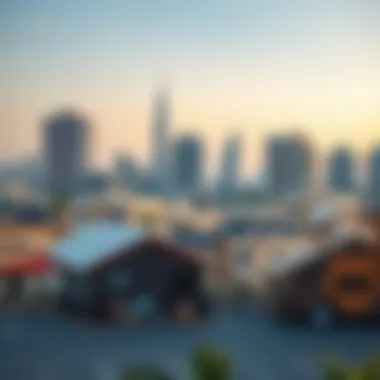
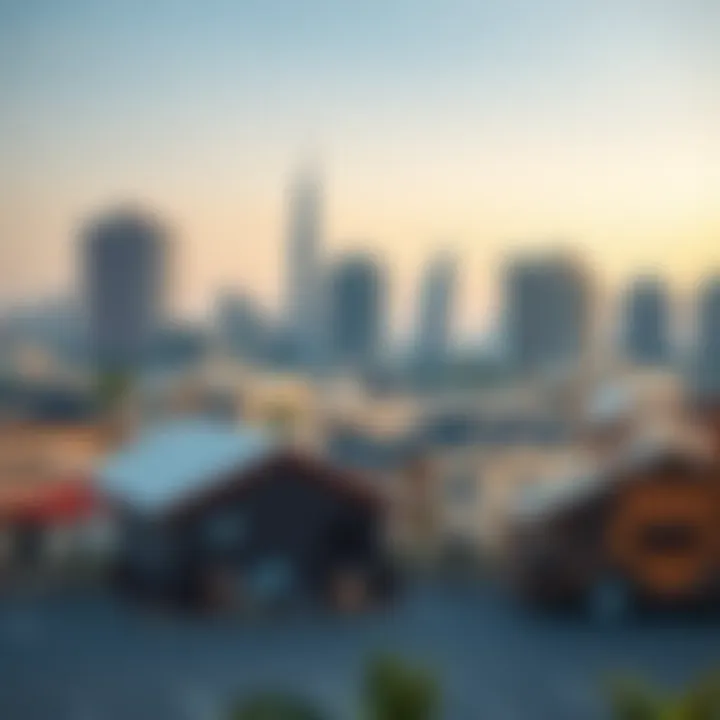
Incentives for eco-friendly homes are critical in promoting sustainable housing in the UAE. The government has introduced various initiatives, such as tax breaks and grants for developers who incorporate green technologies and practices. These incentives make it financially feasible for builders to create homes that are both sustainable and economically viable. The unique feature of these initiatives lies in their ability to stimulate market demand while aligning with the UAE's sustainable development goals. Nonetheless, reliance on government support can lead to uncertainties if policies shift or funding changes.
Regulatory Frameworks
Regulatory frameworks play a pivotal role in the sustainable housing sector by establishing standards and guidelines for building practices. In the UAE, local authorities have developed comprehensive regulations which mandate the incorporation of sustainable practices in new developments. These regulations are vital as they not only ensure compliance but also promote environment-friendly practices among builders. A critical characteristic of these frameworks is their dynamic nature, constantly evolving to adapt to new technologies. However, overly stringent regulations can pose challenges for developers, potentially stalling projects or inflating costs beyond what many investors are willing to tolerate.
Public Awareness Campaigns
Public awareness campaigns serve as a tool for educating homeowners and the broader community about the importance of sustainable living. These initiatives often provide resources and information about the benefits of adopting green practices, from energy-saving tips to the advantages of sustainable materials. Successful campaigns can lead to a greater understanding of sustainability and drive community support for green initiatives. The main strength of these campaigns lies in their ability to reach a wide audience through various channels, increasing the overall impact. However, the transient nature of public interest can sometimes limit their effectiveness, necessitating ongoing efforts to keep sustainability front of mind for the community.
Cultural Influences on Housing
Cultural influences on housing in the UAE are crucial for understanding how residential spaces reflect the identity, history, and aspirations of their inhabitants. The UAE is a melting pot, home to Emiratis and expatriates from a multitude of countries. This diversity not only shapes architectural styles but also influences living arrangements, community layout, and even the materials used in construction. Ultimately, cultural influences reinforce social cohesion and a sense of belonging, while allowing for individual expression and global trends to seep into traditional frameworks.
Bedouin Heritage
Traditional Nomadic Structures
Traditional nomadic structures, such as the tent made from goat hair, demonstrate the adaptability of the Bedouin way of life. The characteristic feature of these structures is their portability, designed to be easily assembled and disassembled as families moved with the seasons. This adaptability underscores the connection between the inhabitants and their environment, allowing them to thrive in a harsh desert landscape. Although such simplicity may appear basic, it embodies resourcefulness and a profound understanding of local conditions.
The benefit of these structures lies in their natural insulation properties, perfect for the extreme climate. However, they may lack modern amenities, which can be viewed as a disadvantage when gauging current housing standards. Yet, these structures remind us of the UAE's rich heritage.
Adaptations Over Time
As time marched on, traditional nomadic structures evolved significantly. Many Bedouin families now integrate modern elements while retaining aspects of their historical roots. This adaptation reflects a key characteristic: blending traditional aesthetics with modern functionality. For instance, while some may still maintain outdoor majlis for community gatherings, the interiors might boast contemporary furnishings and technologies.
This adaptability is beneficial as it promotes continuity and respect for history while accommodating the needs of contemporary life. One disadvantage, however, might be the potential loss of traditional craftsmanship and cultural symbols, which get overshadowed by modern materials and designs. The challenge is finding a balance between preservation and progress.
Symbolism in Design
Symbolism plays a prominent role in the architectural choices reflecting Bedouin heritage. Elements such as intricate geometric patterns and vibrant colors often represent notions of hospitality and unity. The importance of such symbolism lies in connecting residents emotionally to their homes and community.
One key characteristic is the use of design motifs from nature, which resonate with the Bedouin's connection to their surroundings. These motifs make the designs visually distinctive and richer in meaning. However, the integration of non-traditional symbols may lead to dilution or misinterpretation of cultural significance, creating a crucial point for discussion when it comes to modern interpretations of traditional design.
Globalization Effects
Architectural Fusion
Architectural fusion emerges as a defining feature of housing in the UAE. Blendings of influences from various cultures result in a vibrant architectural landscape, showcasing both traditional and modern styles. This phenomenon highlights the benefit of diversity, allowing for innovative designs that appeal to a broad audience. A unique feature here is the popularity of mixed-use developments, combining residential space with commercial and recreational areas.
However, a drawback might be the lack of a cohesive identity; excess fusion can lead to a disjointed architectural landscape that might confuse the rich cultural heritage of the region.
Foreign Investments
Foreign investments have significantly shaped the UAE's housing landscape. The influx of international capital has led to the rapid development of luxurious residential areas and iconic landmarks. One key characteristic of this phenomenon is the upscale branding associated with foreign investments, often attracting wealthy buyers seeking both lifestyle enhancement and profit potential.
This trend benefits the economy and offers opportunities for local contractors and businesses. Nonetheless, an over-reliance on foreign capital may cause domestic markets to fluctuate with global economic conditions, posing risks for local investors.
Shift in Lifestyle Preferences
A noticeable shift in lifestyle preferences has emerged as globalization continues to exert its influence. Many residents are gravitating toward urban living, drawn by the convenience of modern amenities and a bustling lifestyle. One key aspect of this shift is the rising demand for high-rise condo living, which offers both accessibility and a sense of community.
This change encourages innovative residential designs that cater to contemporary lifestyles. However, a potential downside could be the loss of traditional values, with families increasingly opting for individualism over communal living. This trend represents a broader cultural change within the UAE's housing landscape and ignites discussions about balance between community and privacy.
"As the UAE continues to evolve, its housing reflects the delicate balance between tradition and modernity, telling the story of its diverse inhabitants and their aspirations."
Regional Variations in Architecture
When looking at the United Arab Emirates, its architecture tells a fascinating story of regional differences. Each emirate showcases unique styles that are influenced by various factors, including geography, climate, and cultural heritage. Recognizing these variations enriches our understanding of the local preferences and lifestyles, as well as the aspirations of the residents.
Regional architecture not only reflects aesthetic values but also demonstrates adaptive designs that respond to the climate and social structure of the area.
Dubai's Modern Skyline
Skyscrapers and Towers
The skyscrapers in Dubai aren't just tall buildings; they're a bold statement of ambition. These structures dominate the skyline, and for good reason. Their sheer height allows for an impressive view of the surroundings, and they often house a range of functions from residential to commercial. The Burj Khalifa is perhaps the most iconic example. Its design features a slender silhouette that optimizes the use of space and air circulation.
What's more, these skyscrapers symbolize the rapid economic growth of the region, making them both a beneficial investment and a popular tourist attraction. However, some critics argue that such towering structures may overshadow local culture and community spaces, leading to a disconnection among the residents who live below.
Architectural Innovations
Dubai also stands out for its architectural innovations. Cutting-edge technology and sustainable practices are increasingly being integrated into new designs. For instance, buildings like the Al Bahr Towers utilize smart skin technology that adjusts to the sun's intensity, reducing energy consumption. This approach to architecture is not only beneficial from a functional perspective but also adds an element of sophistication. These innovations keep Dubai at the forefront of global architecture, although there is a delicate balance to maintain when it comes to preserving Emirati identity amidst such technological advancements.
Popular Neighborhoods
As for popular neighborhoods, areas like Downtown Dubai and the Palm Jumeirah are prime examples of how regional characteristics influence living arrangements. These neighborhoods boast luxurious amenities and a vibrant lifestyle, attracting both locals and expatriates alike. One key characteristic of these areas is their blend of modernity with aspects of traditional culture—think of a beachfront villa combined with rich Arab architectural elements. However, the downside is the high cost of living, which may put them out of reach for average Emiratis, creating a socioeconomic divide.
Abu Dhabi's Cultural Nucleus
Cultural Institutions
In contrast to Dubai, Abu Dhabi focuses heavily on its cultural institutions. The Louvre Abu Dhabi is a monumental example, designed to represent a mix of Eastern and Western art. These institutions bring a sense of cultural sophistication and recognition to the emirate, demonstrating the importance placed on education and the arts. They are beneficial venues for community gatherings but could face challenges in sustaining interest from younger generations amidst a rapidly modernizing landscape.
Investment Focus
Abu Dhabi's investment focus tilts toward sustainable and innovative housing projects. There's a concerted effort to boost off-plan sales that align with the government's vision for a diversified economy. The unique feature of this approach is its emphasis on green building standards, which appeals to environmentally conscious investors. Nonetheless, while the investor interest is growing, some projects may struggle with execution and delivery timelines.
Unique Residential Areas
Finally, neighborhoods like Al Ain and Yas Island stand out as unique residential areas, known for their lifestyle offerings. Al Ain boasts a rich cultural history and heritage sites, maintaining a more traditional lifestyle approach, while Yas Island offers high-end living complemented by leisure activities. This diversity in residential choices reflects the segmentation of the market, with benefits ranging from community-oriented living to luxury amenities. However, it also presents a challenge in meeting the diverse needs across different demographic segments.
Understanding the regional variations in architecture within the UAE empowers investors to make informed decisions that align with both current trends and future potential.
In summary, the architectural landscape of the UAE is a tapestry of regional nuances ranging from the thrilling heights of Dubai's skyscrapers to the culturally rich neighborhoods of Abu Dhabi. Each area tells a story, and recognizing these narratives can help investors and homebuyers appreciate the diversity of housing types available.
End
The exploration of diverse housing types in the UAE is not just about examining structures or square footage; it speaks volumes about the evolving cultural landscape and society. In this article, we have navigated through traditional roots, modern aspirations, and sustainable practices that interlace to form the fabric of Emirati architectural identity.
Summary of Key Insights
One key insight is the profound significance of traditional Emirati homes. These structures reflect values of community and family, while also revealing adaptations to harsh climatic conditions. Likewise, modern villas showcase luxury and innovation through smart technologies and open layouts, catering to an increasingly globalized lifestyle. In contrast, the rise of sustainable housing practices highlights a growing awareness towards eco-friendliness, with efforts by the government and private sectors aiming to harmonize urban development with environmental responsibility.
Future of Housing in the UAE
Looking ahead, the housing landscape in the UAE appears dynamic and evolving. The trend towards integrating more sustainable practices will likely gain momentum as global concerns over climate change intensify. Additionally, as populations grow and diversify, we can expect increasing demand for various housing types that not only meet needs but also reflect individual identities. Investors and homebuyers will benefit from staying informed about these changes, as emerging neighborhoods and innovative designs shape investment opportunities.
Understanding the layers embedded in housing types clarifies how they mirror lifestyle changes, cultural values, and economic shifts. This deeper grasp can enlighten property managers and investors, aiding in making informed decisions in the fast-moving real estate market of the UAE.
"In the UAE, housing is more than walls and a roof; it’s a timeline of cultural heritage, social dynamics, and future aspirations."
For more extensive insights, resources like Wikipedia, Britannica or Government Reports can provide a wealth of additional information.



